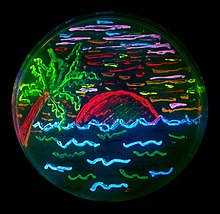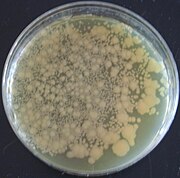Genetically modified bacteria
| Part of a series on |
| Genetic engineering |
|---|
 |
| Genetically modified organisms |
| History and regulation |
| Process |
| Applications |
| Controversies |
Genetically modified bacteria were the first organisms to be modified in the laboratory, due to their simple genetics.[1] These organisms are now used for several purposes, and are particularly important in producing large amounts of pure human proteins for use in medicine.[2]
History
The first example of this occurred in 1978 when
Research
Bacteria were the first organisms to be genetically modified in the laboratory, due to the relative ease of modifying their chromosomes.[3] This ease made them important tools for the creation of other GMOs. Genes and other genetic information from a wide range of organisms can be added to a plasmid and inserted into bacteria for storage and modification. Bacteria are cheap, easy to grow, clonal, multiply quickly, are relatively easy to transform, and can be stored at -80 °C almost indefinitely. Once a gene is isolated it can be stored inside the bacteria, providing an unlimited supply for research.[4] The large number of custom plasmids make manipulating DNA excised from bacteria relatively easy.[5]
Their ease of use has made them great tools for scientists looking to study gene function and
Food
Bacteria have been used in the production of food for a very long time, and specific strains have been developed and selected for that work on an industrial scale. They can be used to produce
In cheese
Chymosin is an enzyme produced in the stomach of young ruminant mammals to digest milk. The digestion of milk proteins via enzymes is essential to cheesemaking. The species Escherichia coli and Bacillus subtilis can be genetically engineered to synthesise and excrete chymosin,[13] providing a more efficient means of production. The use of bacteria to synthesise chymosin also provides a vegetarian method of cheesemaking, as previously, young ruminants (typically calves) had to be slaughtered to extract the enzyme from the stomach lining.
Industrial
Genetically modified bacteria are used to produce large amounts of proteins for industrial use. Generally the bacteria are grown to a large volume before the gene encoding the protein is activated. The bacteria are then harvested and the desired protein purified from them.[14] The high cost of extraction and purification has meant that only high value products have been produced at an industrial scale.[15]
Pharmaceutical production
The majority of the industrial products from bacteria are human proteins for use in medicine.[16] Many of these proteins are impossible or difficult to obtain via natural methods and they are less likely to be contaminated with pathogens, making them safer.[14] Prior to recombinant protein products, several treatments were derived from cadavers or other donated body fluids and could transmit diseases.[17] Indeed, transfusion of blood products had previously led to unintentional infection of haemophiliacs with HIV or hepatitis C; similarly, treatment with human growth hormone derived from cadaver pituitary glands may have led to outbreaks of Creutzfeldt–Jakob disease.[17][18]
The first medicinal use of GM bacteria was to produce the protein
Health
With greater understanding of the role that the
If the bacteria do not form
One example of such an intermediate, which only forms short-term colonies in the
There are concerns that horizontal gene transfer to other bacteria could have unknown effects. As of 2018 there are clinical trials underway testing the efficacy and safety of these treatments.[24]
Agriculture
For over a century bacteria have been used in agriculture. Crops have been

Other uses
Other uses for genetically modified bacteria include bioremediation, where the bacteria are used to convert pollutants into a less toxic form. Genetic engineering can increase the levels of the enzymes used to degrade a toxin or to make the bacteria more stable under environmental conditions.[29] GM bacteria have also been developed to leach copper from ore,[30] clean up mercury pollution[31] and detect arsenic in drinking water.[32] Bioart has also been created using genetically modified bacteria. In the 1980s artist Joe Davis and geneticist Dana Boyd converted the Germanic symbol for femininity (ᛉ) into binary code and then into a DNA sequence, which was then expressed in Escherichia coli.[33] This was taken a step further in 2012, when a whole book was encoded onto DNA.[34] Paintings have also been produced using bacteria transformed with fluorescent proteins.[33][35][36]
Bacteria-synthesized transgenic products
- Insulin
- Hepatitis B vaccine
- Tissue plasminogen activator
- Human growth hormone
- Ice-minus bacteria
- Interferon
- Bt corn[37]
- Terraforming § Other possibilities
References
- S2CID 24578435. Archived from the original(PDF) on 6 November 2009.
- S2CID 3358528.
- S2CID 24578435. Archived from the original(PDF) on 6 November 2009.
- ^ "Rediscovering Biology - Online Textbook: Unit 13 Genetically Modified Organisms". www.learner.org. Archived from the original on 2019-12-03. Retrieved 2017-08-18.
- S2CID 27404861.
- ^ Cooper GM (2000). "Cells As Experimental Models". The Cell: A Molecular Approach. 2nd Edition.
- S2CID 49310760.
- PMID 23704788.
- ^ Pollack A (7 May 2014). "Researchers Report Breakthrough in Creating Artificial Genetic Code". The New York Times. Retrieved 7 May 2014.
- PMID 24805238.
- ISBN 9780123849533.
- ISBN 978-93-80026-33-6
- PMID 25482140.
- ^ ISBN 9781609110819.
- ^ S2CID 2694760.
- S2CID 3358528.
- ^ S2CID 9331069.
- S2CID 26527486.
- S2CID 5986035.
- S2CID 2701961.
- PMID 17636758.
- PMID 17253498.
- ^ Summers, Rebecca (24 April 2013) "Bacteria churn out first ever petrol-like biofuel" New Scientist, Retrieved 27 April 2013
- ^ PMID 29946090.
- S2CID 11066428.
- PMID 17448156.
- PMID 16716759.
- PMID 12595134.
- PMID 29329004.
- ^ Valda D, Dowling J (10 December 2010). "Making Microbes Better Miners". Business Chile Magazine. Archived from the original on 17 December 2010. Retrieved 21 March 2012.
- PMID 21838857.
- ^ Sanderson K (24 February 2012). "New Portable Kit Detects Arsenic In Wells". Chemical and Engineering News.
- ^ PMID 26617334.
- ^ Agapakis C. "Communicating with Aliens through DNA". Scientific American Blog Network. Retrieved 2018-09-13.
- S2CID 9683430.
- S2CID 54910535.
- PMID 20298555.
Further reading
- ISBN 978-0-471-43416-0.


